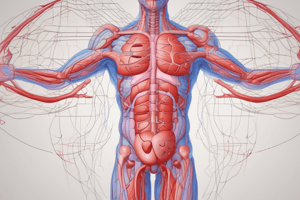Podcast
Questions and Answers
Plasma oncotic pressure is caused primarily by:
Plasma oncotic pressure is caused primarily by:
- lymph.
- electrolytes such as sodium and chloride.
- blood pressure.
- plasma proteins, especially albumin. (correct)
Which of the following is true regarding the sympathetic and parasympathetic arms of the baroreceptor reflex? They carry:
Which of the following is true regarding the sympathetic and parasympathetic arms of the baroreceptor reflex? They carry:
- sensory information from the SA and AV nodes to the spinal cord.
- motor information from the heart and blood vessels to the aortic and carotid sinus baroreceptors.
- motor information from the spinal cord to the heart and blood vessels. (correct)
- sensory information from the baroreceptors to the SA and AV nodes of the heart.
If digital (finger press) pressure is exerted over the carotid sinus, you would expect:
If digital (finger press) pressure is exerted over the carotid sinus, you would expect:
- no effect, because the baroreceptors are "crushed."
- reflex tachycardia.
- that the medulla oblongata will interpret the signal as high blood pressure and therefore fire the vagus nerve. (correct)
- the sympathetics to fire, thereby increasing blood pressure.
While "taking" a blood pressure, you record the first Korotkoff sounds as the:
While "taking" a blood pressure, you record the first Korotkoff sounds as the:
Which of the following might result from ischemia?
Which of the following might result from ischemia?
Loss of speech, paralysis, and possible death can be caused by:
Loss of speech, paralysis, and possible death can be caused by:
Blood flow is slowest in the:
Blood flow is slowest in the:
If capillary pore size increases, as in severe burns,
If capillary pore size increases, as in severe burns,
Which of the following is most likely to develop if the pressure in the pulmonary capillaries increases?
Which of the following is most likely to develop if the pressure in the pulmonary capillaries increases?
The characteristic of the arteriole that allows it to function as a resistance vessel is its:
The characteristic of the arteriole that allows it to function as a resistance vessel is its:
Which of the following is most likely to induce carotid sinus syncope?
Which of the following is most likely to induce carotid sinus syncope?
Your patient's initial blood pressure was 155/95 mm Hg. After 10 minutes, his blood pressure was 125/75 mm Hg. Which of the following best reflects this observation?
Your patient's initial blood pressure was 155/95 mm Hg. After 10 minutes, his blood pressure was 125/75 mm Hg. Which of the following best reflects this observation?
Which artery is most often used to measure blood pressure?
Which artery is most often used to measure blood pressure?
Which of the following is a true statement regarding baroreceptors?
Which of the following is a true statement regarding baroreceptors?
Edema is least likely to occur in which of the following situations?
Edema is least likely to occur in which of the following situations?
Baroreceptors:
Baroreceptors:
Why does blood flow from the arterial side of the circulation to the venous side of the circulation?
Why does blood flow from the arterial side of the circulation to the venous side of the circulation?
ADH increases blood pressure by all of the following except:
ADH increases blood pressure by all of the following except:
Which of the following is most responsible for the plasma oncotic pressure?
Which of the following is most responsible for the plasma oncotic pressure?
Which of the following exerts a vasopressor effect?
Which of the following exerts a vasopressor effect?
If the lymphatic vessels are blocked or surgically removed,
If the lymphatic vessels are blocked or surgically removed,
Which of the following drugs is most likely to increase systemic vascular resistance?
Which of the following drugs is most likely to increase systemic vascular resistance?
Both epinephrine and norepinephrine are:
Both epinephrine and norepinephrine are:
Which of the following is true of vasoconstriction?
Which of the following is true of vasoconstriction?
Which of the following is the most likely consequence of venodilation, or "pooling" of the blood in the venous circulation?
Which of the following is the most likely consequence of venodilation, or "pooling" of the blood in the venous circulation?
Flashcards
Plasma oncotic pressure
Plasma oncotic pressure
Pressure in blood caused by plasma proteins, mainly albumin.
Baroreceptor reflex
Baroreceptor reflex
Reflex that helps control blood pressure through sensory and motor signals.
Carotid sinus pressure effect
Carotid sinus pressure effect
Pressure on carotid sinus signals high blood pressure, activating vagus nerve.
First Korotkoff sound
First Korotkoff sound
Signup and view all the flashcards
Ischemia effects
Ischemia effects
Signup and view all the flashcards
Brain hemorrhage consequences
Brain hemorrhage consequences
Signup and view all the flashcards
Capillaries blood flow
Capillaries blood flow
Signup and view all the flashcards
Capillary pore size effect
Capillary pore size effect
Signup and view all the flashcards
Pulmonary capillary pressure
Pulmonary capillary pressure
Signup and view all the flashcards
Arteriole function
Arteriole function
Signup and view all the flashcards
Carotid sinus syncope
Carotid sinus syncope
Signup and view all the flashcards
White coat hypertension
White coat hypertension
Signup and view all the flashcards
Brachial artery
Brachial artery
Signup and view all the flashcards
Baroreceptor location
Baroreceptor location
Signup and view all the flashcards
Edema conditions
Edema conditions
Signup and view all the flashcards
Lymphatic system blockage
Lymphatic system blockage
Signup and view all the flashcards
Increased systemic vascular resistance
Increased systemic vascular resistance
Signup and view all the flashcards
Adrenal medulla hormones
Adrenal medulla hormones
Signup and view all the flashcards
Vasoconstriction effect
Vasoconstriction effect
Signup and view all the flashcards
Venodilation consequence
Venodilation consequence
Signup and view all the flashcards
ADH function
ADH function
Signup and view all the flashcards
Pressure differences in circulation
Pressure differences in circulation
Signup and view all the flashcards
Plasma protein importance
Plasma protein importance
Signup and view all the flashcards
EDV increase outcome
EDV increase outcome
Signup and view all the flashcards
Decreased oncotic pressure cause
Decreased oncotic pressure cause
Signup and view all the flashcards
Hormonal vasopressors
Hormonal vasopressors
Signup and view all the flashcards
Epinephrine and norepinephrine role
Epinephrine and norepinephrine role
Signup and view all the flashcards
Threshold for blood flow
Threshold for blood flow
Signup and view all the flashcards
Vagal stimulation outcome
Vagal stimulation outcome
Signup and view all the flashcards
Study Notes
Plasma Oncotic Pressure
- Primarily caused by plasma proteins, especially albumin
- Albumin is a key protein in maintaining the oncotic pressure of blood.
Baroreceptor Reflex
- Sympathetic and parasympathetic arms carry motor information from the spinal cord to the heart and blood vessels.
- Sensory information from baroreceptors travels to the SA and AV nodes
- This information is used to regulate blood pressure.
Korotkoff Sounds
- The first Korotkoff sounds indicate the systolic blood pressure reading.
Ischemia
- Can lead to tissue damage, pain, and gangrene.
Blood Vessel Rupture in the Brain
- Can cause loss of speech, paralysis, and potential death.
Slowest Blood Flow
- Blood flow is slowest in the capillaries, reflecting the exchange of nutrients and waste products.
Capillary Pore Size and Burns
- Increased capillary pore size in severe burns results in albumin leaking into the tissue space.
Pulmonary Edema
- A consequence of increased pressure in the pulmonary capillaries.
Arteriole Resistance Vessel
- The smooth muscle in arterioles controls blood vessel diameter, therefore regulating resistance.
Carotid Sinus Syncope
- Can be induced by pressure on the carotid sinus, often caused by a tight collar.
White Coat Hypertension
- A temporary increase in blood pressure when a patient is in a medical setting.
Brachial Artery for Blood Pressure Measurement
- The brachial artery is commonly used to measure blood pressure.
Baroreceptors Location
- Baroreceptors are located in the carotid sinus and aortic arch.
Plasma Osmolarity and Starvation
- Decreased plasma oncotic pressure can be caused by starvation or conditions with decreased protein levels.
Lymphatic Vessels and Edema
- Fluid and protein accumulating in the interstitial space leads to edema when lymphatic vessels are blocked.
Systemic Vascular Resistance and ADH
- ADH does not activate baroreceptors; instead, it acts as a vasopressor and increases blood volume to raise blood pressure.
Oncotic Pressure and Albumin
- Albumin is a crucial protein influencing the oncotic pressure primarily.
Venodilation and Venous Return
- Venodilation or pooling of blood in the venous circulation reduces venous return.
Studying That Suits You
Use AI to generate personalized quizzes and flashcards to suit your learning preferences.
Related Documents
Description
Explores plasma oncotic pressure, baroreceptor reflex, and Korotkoff sounds. Discusses ischemia, blood vessel rupture in the brain, and blood flow dynamics. Examines capillary pore size changes in burns and the onset of pulmonary edema.




